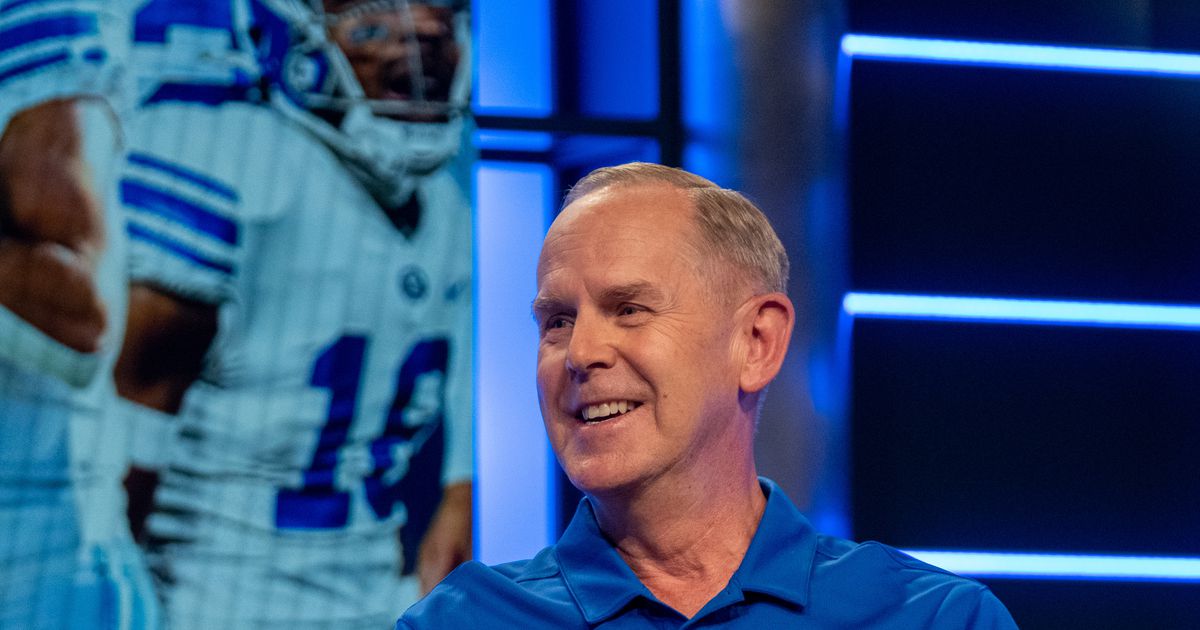(Trent Nelson | The Salt Lake Tribune) Tom Holmoe at BYU football media day in Provo on Wednesday, June 22, 2022.
When BYU announced plans this week to enter the world of NFTs, officials said they believed the venture might be worth $20 million in the first year alone.
The five-year deal, in theory, would give Utah tech company Ocavu the rights to create non-fungible tokens — in this case similar to digital trading cards of BYU football players — for fans to purchase. In turn, the athletic department and the athletes would receive an undisclosed percentage of the profits when an NFT is sold.
But the agreement was quickly met with skepticism by experts, who cited the risks in the NFT market and surprise that BYU would place itself in the volatile industry.
“Other larger brands [in college football] have been hesitant to wholesale embrace NFTs,” Matt Brown said, who writes a newsletter about the business of college athletics. “The market is volatile. There is a reputational risk from the institution. And it is unclear how large the consumer demand is.”
When the partnership was announced, the Lehi-based Ocavu projected that the deal could be worth up to $20 million dollars in the first year. BYU billed the deal as a victory for both the athletic department and the athletes to make money in the NIL space.
But Brown scoffed at that value projection and noted the greater risks.
During the summer, the market for NFTs declined by 92%, according to the data website NonFungible.com. The number of active users declined by 88%.
Many experts believe the NFT bubble popped in June, after months of people flipping NFTs for extremely high prices. Now, the fallout from those exorbitant prices is cratering the industry.
As a result, other college programs that have been approached by NFT companies have declined. Miami briefly flirted with NFTs in 2021, but did not have success.
“When we first started having these NFT conversations, the NFT market was still really robust,” Casey Stauffer, BYU’s associate athletic director, said. “But from the very beginning we didn’t want [the marketplace] to be about speculation. We talked about creating experiences, something more valuable than saying, ‘I have a JPEG.”
“We thought about [the risks]. I believe the platform will be more utility driven and experience driven than speculation driven.”
BYU and Ocavu acknowledged the NFT market has been “bloodied” and that BYU’s marketplace is a risk. Yet, Stauffer emphasized that this NIL deal will not hinge on people buying and selling NFTs alone.
BYU says that when a fan buys an NFT, they will also get other experiences with it. That, BYU believes, will make the platform more immune to the swings of the NFT space. The NFTs, they say, are just an avenue for people to buy experiences.
“This is as close as we can get [to being immune from speculation], because of our focus on experiences,” Stauffer said.
“Was there a moment [when we were hesitant]? At the beginning, yes,” he continued. “We didn’t want it to be perceived the same way as other NFTs are being perceived. We want this to be an asset. But this is much more experience oriented, and about engagement, than it is about NFTs. Our goal wasn’t about creating a speculative market, it was about what was behind those.”
However, some experts say that any value placed in NFTs is inherently risky. A major part of this deal revolves around an up-and-down market.
“I would say it traditionally has been, and probably will continue to be, a fairly volatile market,” Tim Neilsen, who runs a Utah NFT company called Cloutchain, said. “It is partly because of the nature of the new technology. People are still learning what it is and what it means. With that comes ebbs and flows of adoptions.”
The appetite for BYU fans buying NFTs is another concern. BYU acknowledged there is not a high demand for buying NFTs alone.
This was a red flag to Brown, who noted that NFTs are expensive to make. Ocavu said it has already spent $2 million in making the current NFTs. It also will likely spend $2 million more next year. Ocavu said it will take a portion of the profits to cover the overhead expenses.
“If you take a macro step back, and you look at the NFT marketplace, it is pretty bloody in the last six months,” Jon Cheney, the CEO of Ocavu said. “Last year everything was soaring. It was during all that Ocavu decided to get into NFTs because we saw problems [in the industry]. There is no way a picture is worth $50 million just because it is an NFT.”
The question Brown and others are asking, is why BYU would take the risk on NFTs. There are other NIL deals out there that can generate similar revenue. Also, there are other NIL deals that would give a higher percentage of the profits to the athletes.
Ocavu has declined to say what percentage of the profits will go to athletes, the athletic department and how much will be kept by the company.
“I would imagine that other group licensing, consumable opportunities, would be much less risky [for BYU],” Brown said. “And it would likely provide similar value to athletes than NFTs.”
Donate to the newsroom now. The Salt Lake Tribune, Inc. is a 501(c)(3) public charity and contributions are tax deductible
Report a missed paper by emailing subscribe@sltrib.com or calling 801-237-2900
For e-edition questions or comments, contact customer support 801-237-2900 or email subscribe@sltrib.com
sltrib.com © 1996-2022 The Salt Lake Tribune. All rights reserved.
Author
Administraroot

